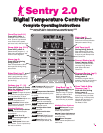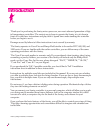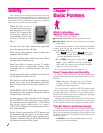
Low Fire Cones 022 - 011
This range includes decals, over-decorations, lusters,
and golds. The firing can befast. Good venting is important,
because oils andother organics burn off. Do notclose the lid
from the vented position until all odor has disappeared.
Low Fire Cones 022 - 011 Firing Schedule
Segment Rate Per Hour Time in Segment
1 396°F/220°C 2 hours
2 108°F/60°C 1 hour
Firing time is about 3 to 5 hours, depending on the cone and speed.
Middle Fire Cones 010 - 01
Use this range for earthenware and commercial low-fire
glazes. Glazes fired on bisque ware (ware that has already
been fired)canbe firedfaster thanthe unfiredgreenware. In
thiscone range,slow firingscanproduce poorqualityglazes.
In the following schedule, the firing is slowed during the
silica phase change (1063°F/573°C).
Earthenware andclays thatcontain ballclays, talc, andka
-
olin will burn off water, carbon, and sulfur. This reduces
weight by 10%.
Cooling too fast can produce glaze pinholes, blisters, and
craters. Unless cooling isslowed near 1063°F/573°C, a phys-
ical change in the silica can cause the ware to crack. For this
reason we recommend that you use Cone-Fire’s Slow
Cooling option (see page 11).
We recommend a 10 - 20 minute hold when firing
lead-free glazes.
Middle Fire Cones 010 - 01 Firing Schedule
Segment Rate Per Hour Time in Segment
1 324°F/180°C 2 hours, 30 minutes
2 153°F/85°C 35 minutes
3 180°F/100°C 2 hours, 40 minutes
4 108°F/60°C 1 hour, 30 minutes
Firing time is about 6 to 8 hours, depending on the cone and speed.
High Fire Cones1-10
This is the firing range for porcelain and stoneware.
These bodies fire nearly to vitrification and can shrink up to
16%. Water, carbon and sulfur burn out during the early
stages and mustbe vented. The amountof oxygen in thekiln
affects the color of the fired clay. The high fire schedule be
-
low slows down during the last 210°F/100°C to produce
better density in the ware.
Typical porcelain clays are formulated from kaolin, feld
-
spars, silica and ball clays. Weight loss is 10 - 12% and
shrinkage is as high as 20%. If overfired, porcelain may warp
or blister. Cone-fire’s Hold option usually enhances porce
-
lain.
High Fire Cones 1 - 10 Firing Schedule
Segment Rate Per Hour Time in Segment
1 324°F/180°C 2 hours, 30 minutes
2 153°F/85°C 35 minutes
3 162°F/90°C 4 hours, 35 minutes
4 108°F/60°C 2 hours
Firingtimeisabout9hours,30 minutesto11hours,dependingontheconeand
speed.
Cone-Fire Features
Speed (SPd)
The Cone-Fire schedules shown on this page are stan
-
dard. When you select Medium speed in a Cone-Fire pro
-
gram, the kiln uses these standard firing schedules. When
you select Fast (1), the standard schedule fires 20% faster.
On Slow (3), it fires 20% slower.
Youcan alsoalter thefiring speedeven moreunder Speed
(Spd) in Options. See page 17.
Pre-Heat (PRHT)
Moistgreenware canexplode duringfiring. Thishappens
when themoisture inthe clayturns tosteam rapidlyand can-
not escape fast enough. The Sentry Pre-Heat feature dries
the ware at low temperature before the moisture can turn to
steam.
Pre-Heat is sometimes necessary when firing thick
greenware, such as stoneware. It may also be necessary in
humid weather, which inhibits drying. If possible, however,
avoid using Pre-Heat to dry greenware. If the greenware
feels dampor coolwhen youtouch itto yourcheek, dryit lon-
ger before firing. Use a dehumidifier in humid weather.
Drying greenware in the kiln tends to rust the kiln.
Note: DuringPre-Heat, ventthelid. Otherwisethe
firebricks will absorb moisture, leading to rust be
-
hind the steel case. Moisture in the firebrick can
also slow the firing to a crawl.
CAUTION: Venting the lid during Pre-Heat is so
important that some ceramists use the extended
vent position or even leave the lid open. If you do
this, you must be near your kiln at the end of
Pre-Heat to lower the lid.
Pre-Heat raises the temperature 60°F/33°C per hour to
200°F/93°C. Then it holds at 200°F/93°C for the time you
specify. Pre-Heatworks inCone-Fire only.After Pre-Heatis
finished, the kiln will automatically begin firing to the cone
you have selected.
Note: At high altitude, water boils at a lower tem
-
perature. This may cause moisture in the ware to
turn to steam even during Pre-Heat.
9


















